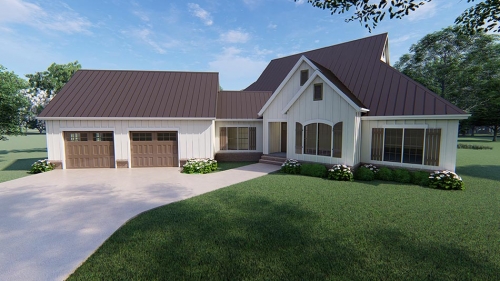Building Your Dream Home: Framing

Building Your Dream Home: Framing
Published at April 14 2025 by JFord
A house frame is like the skeleton of your home. You want it to be built strong and right and with the best materials available. So if you’re a homeowner building your own home or having your first home built, how do you know if your home is getting a good set of bones?
The plan featured above is our New Haven Place (MEN 5206) plan.
Materials
The first step to getting the best skeleton possible is to have the best materials. When we are young we drink milk and eat lots of healthy foods to make sure that our bones and bodies become stronger. There aren’t any vitamins for houses, but you can get the best materials available to build with.
Did you know that there are grades of lumber? That, like diamonds, each piece of wood that comes into a lumber yard is judged by the quality? Most lumber mills will carry different grades of lumber and let you know up front which one is the best one to buy. The best grade of lumber is 1. The quality of the material decreases as the number increases. The better quality lumber is going to be more expensive.
While it is true that the better quality is going to be higher priced, you’ll want to buy the best lumber that you can afford. Remember, these are the bones of your home. These walls are going to support every piece that will go on top of them, including your roof. Using lower quality lumber can cause problems later. Sometimes these problems aren’t even apparent until the home has been lived in for a few years.
Today’s construction is not just limited to your traditional lumber. New techniques and materials are coming out every year to make it more affordable and easier to build a home. One of those advances is engineered lumber. Engineered lumber is usually a composite of lumber byproducts and engineered woods. These are then put together and used in a variety of applications.
While this may seem strange to use lumber that doesn’t technically come from trees, there are advantages. Traditional lumber is limited by the size of the tree that it came from. So it will never be longer than the tree was tall. Engineered lumber does not have that limitation. And since engineered lumber is made from byproducts of the lumber industry, it cuts down on the industry having to mill so many trees. So it is more environmentally friendly.
A joist is a piece that goes across a long stretch where a floor or a ceiling is going to be. An I-Joist is like a steel I-beam made out of wood. These joists are constructed much the same way the engineered lumber is and are incredibly strong. They can come in lengths of up to 60 feet and can have holes cut out for plumbing and ductwork without compromising the strength of the wood.
How is a Frame Built
House Framing may seem like a complicated process but it is much simpler than it looks. Framing is basically several different steps pulled together to make a seamless whole. If you take the process step by step, you find that it is much easier than it seems. You’ll want to start with a good foundation.
Depending on what type of foundation you have chosen for your home will determine your first step. If you have a slab foundation, congratulations you’re ready to start building a frame. If you have a basement or crawlspace, you have one more additional step before you can start the building process. With a basement or crawlspace, you are going to need to put in a subfloor.
The subfloor consists of a large square running the length and width of the foundation and joists laid across the open space. You’ll want the joists to rest on the footers or support columns from your foundation. Then plywood will be run across and over the space creating a floor. Now you can start with the framing itself.
The first step in framing is to put in a sill plate. These are pressure treated pieces of lumber that are made to be insect and moisture resistant. These pieces of lumber are the bottoms of all of your walls. They are anchored into place using long bolts every couple of inches until they are secure.
Once the sill plate is in place, it’s time to start doing the actually framing. There are two methods to framing: Balloon Framing and Platform Framing. Balloon Framing was mainly used in homes built prior to the 1930’s. It’s still used today in homes if the structure is going to be two-story and have masonry work or stucco work on the walls. These types of homes shrink and settle more uniformly than homes with Platform Framing so the masonry work will run less risk of cracking.
Balloon Framing is where the studs (the boards that run vertically from the sill plate to the ceiling) run all the way from the sill to the top plate. These studs can run all the way to 20 feet in the air. While this type of construction is more difficult, it does leave openings for plumbing, electrical and duct work without having to go through and make cut outs.
The second story floor joists (where the second story floor will sit) are usually ribbon board that has been set into the studs. This makes for a very sturdy home. Balloon Framing is a bit more dangerous, though. The massive height and weight of the framing makes it very difficult to raise the walls. It is also becoming increasingly more expensive as the long, light boards that are used to frame the entirety of the home are becoming harder to source.